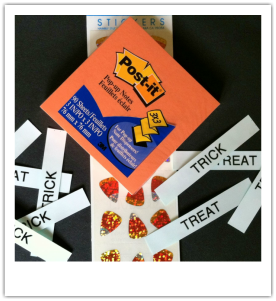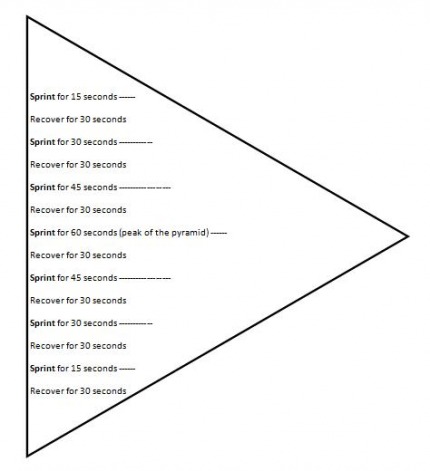|
Have you ever attended an indoor cycling class where someone was wearing a wig, or a tiara, or even a cape? Well, I have and I encouraged it! Yes folks, it's that time of year again when adults get to play dress up, at least in my classes, and we play Thriller by MJ for the whole class! What will you do with your class this year? Here's one idea (want more ideas? Check out my previous posts here and here on Halloween games) using homemade Trick or Treat cards. This is an easy way to incorporate “tricks” (i.e., challenging drills) and “treats” (i.e., easier drills). Simply have participants pick a card, either trick or treat, and the predetermined drill assigned to that card will dictate what drill is performed. I’ve decided to have six possible tricks and three possible treats. Possible Tricks: 1. Two minutes of jumps with 30 second break; repeat two to three times 2. Two one minute standing hill climbs and a couple two minute standing hill climbs; 15 second recovery between each climb 3. Five one minute sprints with 30 seconds recovery between each sprint 4. 15 squats off the bike followed by one minute of seated hill climb; repeat two times (be watchful of participants’ footwear particularly if they are wearing cycling cleats) 5. 10 sprints for 15 seconds. Recover for 45 seconds. 6. Attack the pack power! Six intervals of seated power for 30 seconds, recover for 30 seconds Possible Treats: 1. Standing jog/ride for two minutes 2. Meet your neighbor spin out. Participants discuss best and worst Halloween costume they ever wore for three minutes. 3. Steady time trial pace for six minutes singing to the song everyone knows the words to, Thriller (the album version is 5:58) After you've constructed your family’s costumes and your Halloween decorations, it's easy to whip up these trick or treat cards. Here's how I did it:
Step one: collect crafty items such orange post-it notes, black card stock, "trick" (6) and "treat" (3) labels, and fun Halloween pictures or stickers.
1 Comment
Do your cycle participants groan when they hear sprints? It’s time to liven up sprints by adding an imagination component. I usually cue cycle participants to put on their imagination hats and get ready for the main event.
Wikipedia states that imagery is the “usage of details and descriptions in order to create a sensory experience”. As group fitness leaders we are able to transport our cycle participants to new and exciting places, particularly when they need to sprint. In a cycle class, imagery can: · Set the mood (excitement, enthusiasm, competition, to name a few) · Define a focus and purpose to the drill · Allow for mental distraction to get through a difficult drill Over the many years I’ve been teaching, I’ve come up with various images associated with sprinting that help cycle participants push past their limits. Typically, each sprint is for one minute with one to two minutes active recovery between each sprint. Here are some of my favourites. General themes 1. Visualize yourself racing a childhood friend (add situational cues of your childhood bike) 2. Visualize yourself racing a family member (we always have one family member we are slightly competitive with) 3. Visualize yourself in the Rocky Mountains and you are being chased by a grizzly bear! Sport themes 1. Visualize yourself racing your greatest competition (particularly when working with a sports team, have athletes picture their competition) 2. Visualize yourself racing for the last spot on the Canadian National Cycling Team (the coach is on the sidelines timing your sprint and you need to impress him/her) 3. Visualize yourself racing in first place with a competitor on your back wheel (one minute to the finish line!) Lifestyle themes 1. Visualize yourself racing to a store full of the newest and greatest video systems (e.g., Xbox Kinect) or video games (e.g., the newest Halo) and you’re after the last copy 2. Visualize yourself as a bride-to-be and you are racing into the wedding dress discount sale that happens only once per year (if you’ve never seen the racing heart rates of brides-to-be, check out this video) 3. It is December 26 and you’ve been waiting since 4 am to get inside your favourite electronic shop to get your overlooked Christmas gift, that big screen TV. Visualize yourself rushing the front door and heading straight for the TV section to find your prized gift. Holiday themes As it being Halloween today, I would be remised not to mention a Halloween themed sprint. 1. Visualize yourself trying to exit a haunted house but can’t find the door. Frankenstein appears as you race out of the house, down the stairs and out into the dark of night (okay, so maybe I’ll never be a thriller book author!) 2. Visualize yourself as the lead reindeer on Santa’s sleigh and you must hurry to deliver presents for Christmas 3. Visualize yourself as one of Santa’s elves who is responsible to get all of the presents onto Santa’s sleigh on December 24 I’ve provided some examples that will engage your cycle participants to sprint their hardest to reach their goal. Make up your own that best suits your class. When I listed the benefits of imagery, I neglected to say that it also makes the sprints FUN! Always finding ways to engage, encourage and provide a place for play is our goal. Now go out and get your class sprinting! The first couple classes of a new session are a great time to get the class practising fundamentals – using resistance and cadence to dictate their workout. These two drills are great for the first few classes as they are interactive but also introduce some important concepts. The drills are also good for the beginner classes to give cycle participants a taste of what a cycle class can be like.
Stand Up, Sit Down Wave As we know, it is important to add resistance to the flywheel as we stand up out of the saddle. The drill emphasizes this principle but also allows cycle participants to ‘play’ with their resistance. Starting at the front of the room, prompt the first cycle participant to stand up and add more tension. As soon as the first participant stands up, the next participant follows suit by adding tension and standing up. The ‘wave’ begins and participants remain standing until the last participant joins the others. The wave can continue from the back of the room, where the last cycle participant decreases his/her tension and sits down. The wave will move through the group quickly and can last several cycles. If you want to change it up, try starting at the back of the room, this forces participants to watch for the wave especially with their peripheral vision (excellent skill to have when riding on the road!). Encourage cycle participants to add more resistance on each round of the drill. An alternative to this drill would include having cycle participants maintain the same tension they set for standing in the sitting position. Musical Bikes One of the fun parts of being a cycle group fitness leader gets to play DJ! This drill focuses on cadence by using the music volume to dictate speed. As the song starts, keep the volume low (slower cadence) and progressively add more volume over 30 seconds to take cycle participants into a sprint pace. Hold the sprint pace for 30 seconds then slowly decrease volume and prompt participants to slow their cadence. Repeat up to six times. Choose a song that is between 140-150 bpm. Note: To ensure auditory health, keep the high music volumes below 90 decibels. Games are always fun to play in a cycle class. Try these two games with your beginner participants to help them learn the basics on the bike! A gradual increase in sprint duration may be one way to get more sprinting into a workout. Using a pyramid format, starting with an increased duration to the peak and then decreasing duration, can be a progressive way to increase intensity to your workout. I find varying the duration of your sprint in this way leads you to challenge yourself more. Let's take a look at what I mean... Duration = 7.5 minutes Cadence = 100+ rpm for sprints; 80-90 rpm for recovery Resistance = set tension slightly higher than your steady state, moderate pace (e.g., 4-5 out of 10); during recovery resistance can be turned down slightly to make it easier (for beginner or less fit cycle participants); to challenge more advanced cycle participants keep the resistance the same for sprint and recovery. u The pyramid above may help visualize the drill. Now take yourself to the peak and back!
The song title is fitting for the time of year we are moving into - WINTER. This cycle drill is more suited to mid to advanced cycle participants. Using the song "Wizards in Winter" a combination of sprints and power (increased resistance and cadence) can be timed to coincide with the instruments used. Set resistance at moderate or slightly higher to get your best sprint work/small recovery tension. Power (either seated or standing) requires participants to up the resistance and maintain increased cadence. Get ready for a 3 minute ride of your life! Intro (12 s) Sprint (5-6 s); 100+ rpm Quick break (2- 8s) ; 80-90 rpm Repeat three more times to the intense synthesizer playing Break (8 s) Power (20 s) to the slow guitar playing Break (6-8 s) Sprint (5-6 s); 100+ rpm Quick break (2- 8s) ; 80-90 rpm Repeat one more time to the intense guitar/playing Power (25 s) to the slow guitar playing Break (6-8 s) Sprint (5-6 s); 100+ rpm Quick break (2- 8s) ; 80-90 rpm Repeat one more time to the intense violin playing Sprint (15 s) Power Finish (18-20 s) Wizards in Winter Trans-Siberian Orchestra |
Workman's Cycle Drills & Skills
Enjoy some of my favorite cycle workout drills either in a cycle class or on your own bike at home! Archives
September 2013
Categories
All
|
Edmonton, Alberta


 RSS Feed
RSS Feed